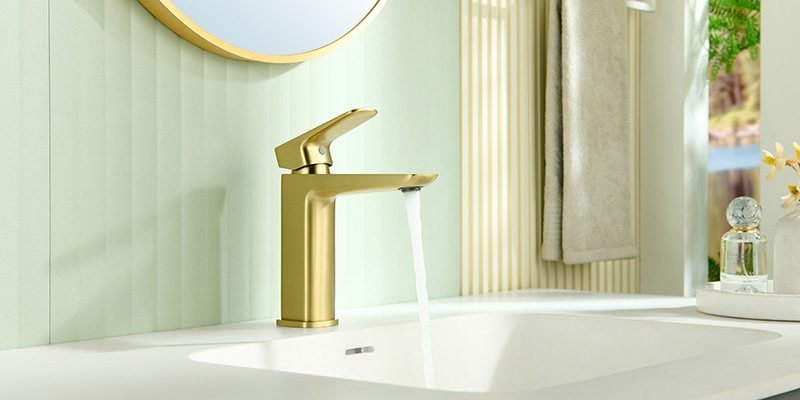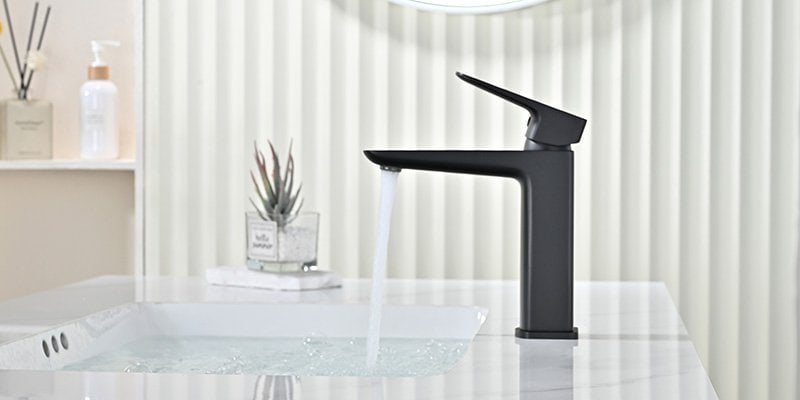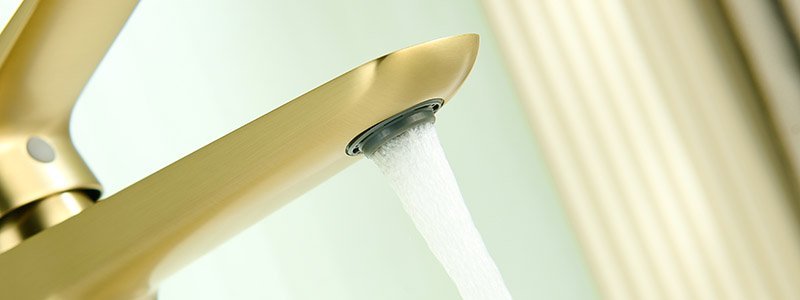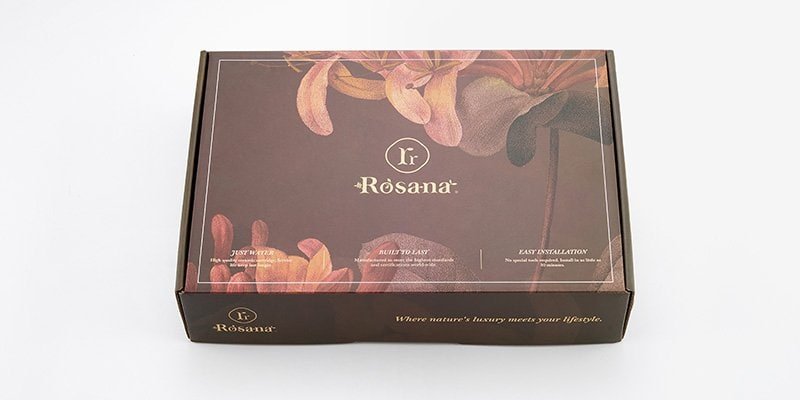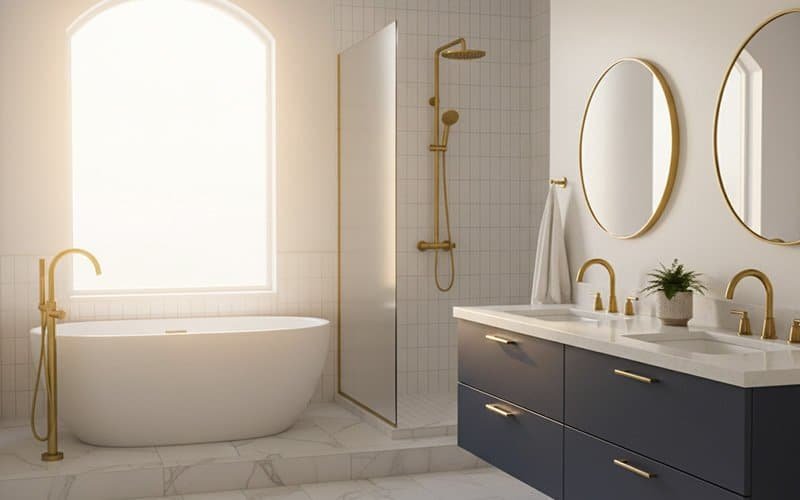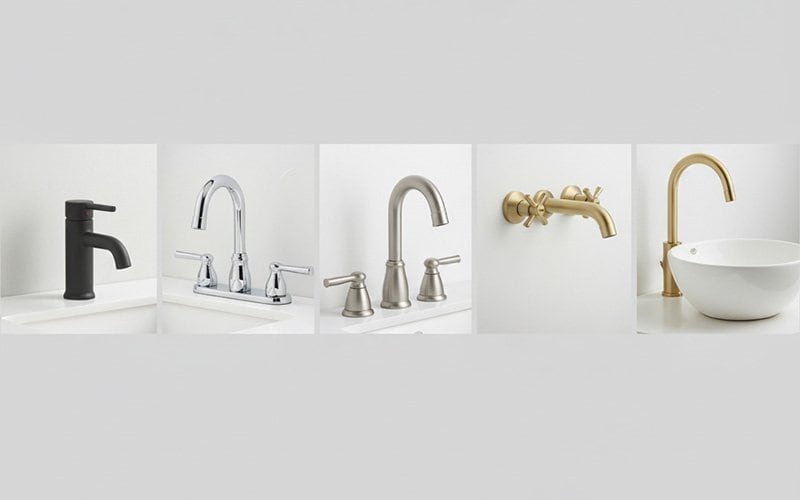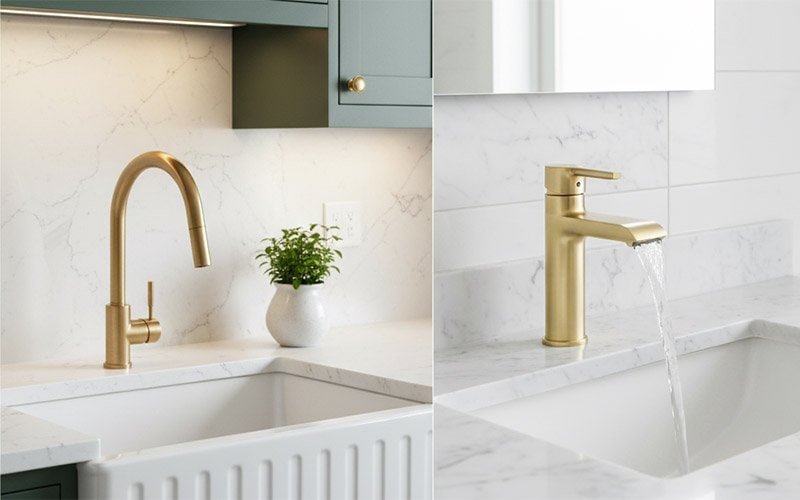Table of Content
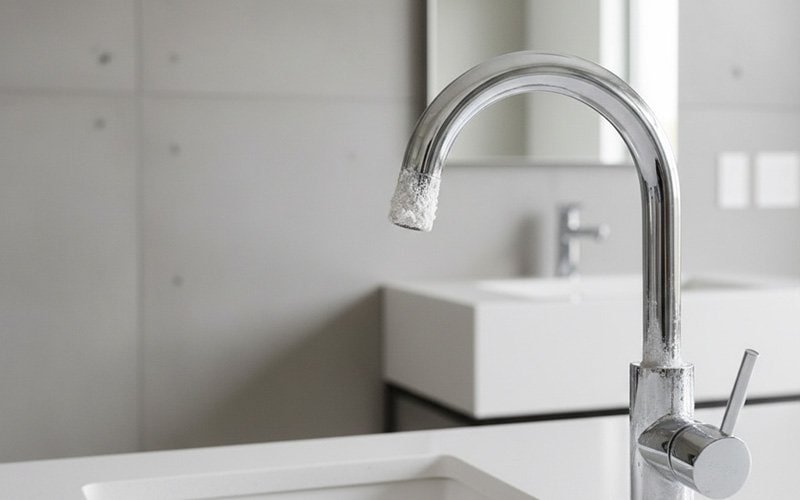
Have you ever stared at the crusty white rings around your faucet, wondering if they will ever come off? You’re definitely not alone! These stubborn mineral stains are like uninvited guests that just won’t leave. Hard water is a widespread issue affecting an astonishing 85% of US households, often leading to unsightly deposits and problems with faucet functionality.
But don’t worry! This guide is your new best friend when it comes to understanding, selecting, cleaning and maintaining your faucet finishes for hard water, especially if you live in an area with hard water. We’ll help you keep your fixtures shining and working beautifully for years to come.
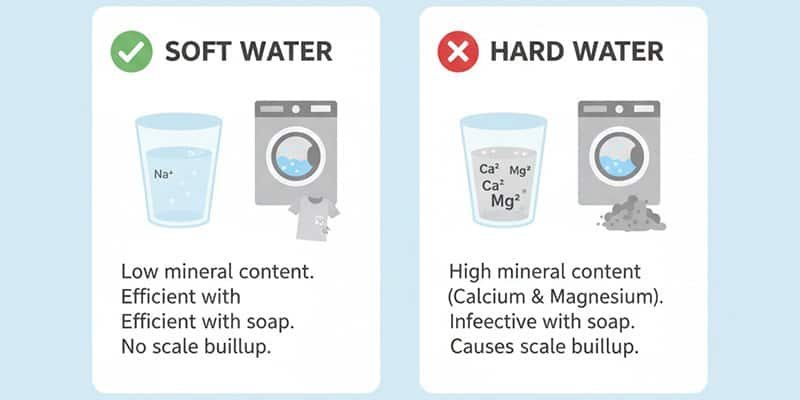
What is Hard Water and Why is it a Faucet’s Nemesis?
Before we can battle the beast, let’s get to know it a little better. Simply put, hard water is water that contains high levels of dissolved minerals, mainly calcium and magnesium ions.
These minerals are naturally picked up as water flows through geological formations like limestone, chalk, and gypsum in the Earth’s crust. While not a direct health risk, this mineral-rich water is the primary antagonist in the story of your home’s plumbing and fixtures.
So, why is this a problem for your beloved faucets? The issue is not singular; hard water wages a multi-front war on your home. The visible stain on a faucet is not the core problem but rather a symptom of a systemic condition affecting the entire plumbing ecosystem.
This perspective shifts the goal from merely cleaning a spot to managing a home-wide challenge.
Unsightly Stains & Residue
When hard water evaporates off your faucet surfaces, it leaves these minerals behind, creating what we commonly call limescale, scale, or that chalky, crusty white residue we all love to hate. This buildup makes even the most elegant fixtures look dull, tarnished, and unkempt.
Depending on the specific mineral content of the water, these stains can appear as white or greenish deposits, or even red or brown if iron is present.
Reduced Functionality
It’s not just about looks! This mineral buildup can actually clog up your faucet aerators and pipes, which means less water flow and lower water pressure over time. The tiny openings in faucet spouts and showerheads are particularly vulnerable to these blockages.
What begins as a powerful stream can dwindle to a frustrating trickle, directly impacting daily tasks like washing dishes or taking a shower.
Appliance Lifespan & Efficiency
Those mineral deposits don’t just stay in your faucet; they can travel into your major appliances like washing machines, water heaters, and dishwashers. Inside a water heater, minerals separate from heated water and settle at the bottom, forming a thick layer of sediment.
This forces the heating element to work harder to heat the water, leading to higher energy bills and reducing the appliance’s lifespan by as much as 25-40%.
Similarly, buildup in dishwashers and washing machines reduces their efficiency and can lead to premature failure.
Finish Damage
If you let those crusty deposits linger for too long, they can actually “eat away at certain finishes” and compromise your faucet’s beautiful look. The minerals can react with the metal surfaces, accelerating corrosion and potentially damaging the rubber washers that seal the fixtures, which in turn creates leaks.
Plus, hard water minerals can react with soap to form soap scum, a sticky, filmy residue that leaves a dull buildup and even “permanent rings” on your fixtures.
The bottom line? That chalky stuff you’re seeing isn’t just dirt. It’s mineral buildup, and tackling it (and preventing it!) requires a little know-how.
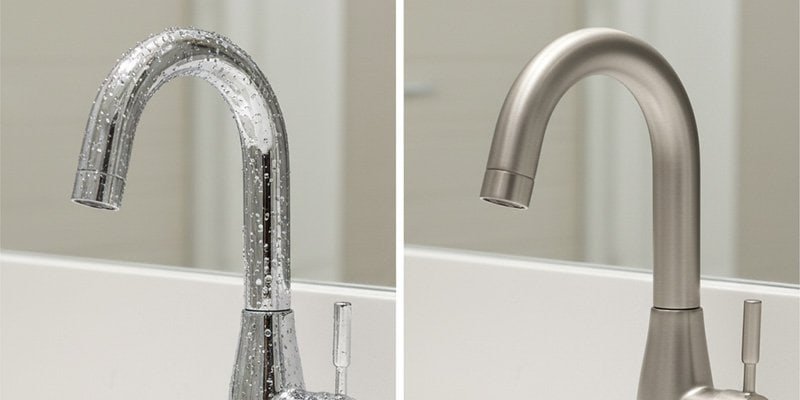
Choosing Hard Water-Friendly Faucets
When you’re dealing with hard water, one of the smartest moves you can make is to choose faucets that are designed to resist its effects. This choice is not merely about aesthetics; it is a strategic commitment to a particular cleaning and maintenance lifestyle.
A beautiful, high-shine faucet may look stunning in the showroom, but in a hard water area, it represents an implicit agreement to wipe it down constantly.
Conversely, a faucet with a more forgiving finish frees up time and reduces cleaning-related stress.
Understanding Your Water
First things first, it’s super helpful to know just how “hard” your water actually is! Most local governments label water as “hard” if it has an ionic concentration of over 60 parts per million (PPM) or 3.50 grains per gallon (GPG).
You can often find this information in your local water utility reports or by using a home testing kit. Knowing your water quality can guide your choices.

Material Matters: The Foundation of Durability
The material your faucet is made from plays a huge role in how it stands up to hard water.
- Brass: This is one of the most durable materials out there for faucets. It’s highly resistant to corrosion, rust, and high temperatures. Plus, brass tends to be less prone to mineral buildup, making it a premium, long-lasting choice. While it can be more expensive, its longevity often makes it a sound investment.
- Stainless Steel: Another excellent choice, stainless steel is strong, non-corrosive, and requires minimal maintenance. It’s highly resistant to hard water stains and corrosion, making it a favorite for its sleek, modern look and robust performance. Its primary drawback is that some finishes can be prone to showing fingerprints and water spots.
- Zinc & Zinc Alloys: If you’re on a tighter budget, zinc faucets can be an option. They’re lightweight and easy to install, but keep in mind they’re not as durable as brass or stainless steel. Their performance against hard water is heavily dependent on a high-quality protective coating. If this coating is compromised, the underlying zinc can corrode over time.
The Best Faucet Finish For Hard Water
The finish of your faucet isn’t just about style; it’s a “secret weapon” against mineral deposits. Different finishes offer varying levels of protection and can make stains more or less noticeable.
Top Performers Faucet Finishes for Hard Water
Satin Nickel (Brushed Nickel)
This finish is a true champion for effectively hiding hard water stains. Its slightly textured, matte surface reduces the visibility of water spots and fingerprints by diffusing light.
Even better, its soft silver-gray color is similar to typical water deposits, creating a “visual camouflage effect” that makes limescale blend in rather than stand out. It’s also durable and resistant to corrosion, rust, and scratches, making it a low-maintenance dream come true.
Satin Brass (Brushed Gold):
Much like satin nickel, satin brass has a textured appearance that helps hide hard water stains.
It offers a luxurious, warm, and inviting color that works with various styles. While it’s resistant to rust and corrosion, it may require some special, gentle care to stay pristine.
PVD (Physical Vapor Deposition) Finishes
If durability is your top priority, PVD finishes are incredibly impressive. PVD is a high-tech process conducted in a vacuum chamber where a solid metal is vaporized and then deposited atom-by-atom onto the faucet, creating a molecular bond.
This results in an exceptionally hard surface that is highly resistant to corrosion, scratches, fading, and tarnishing. This makes them a fantastic choice for areas with high humidity or salty air, like coastal properties. They’re also environmentally sustainable and easy to clean.
Stainless Steel Finish
Naturally resistant to hard water stains and corrosion, stainless steel offers a sleek and modern look that performs great against hard water.
Good Choices (with Important Considerations)
Chrome Finish
Chrome is a classic and popular choice for a reason – it’s durable, resistant to rust, corrosion, and tarnishing, and its smooth, non-porous surface is easy to clean.
However, its highly reflective surface can “amplify the appearance of water spots and mineral buildup,” making them quite noticeable.
Bronze Finish (Oil-Rubbed Bronze)
Bronze faucets add elegance and warmth to any space, with a timeless or rustic charm. They resist scratching and mineral buildup.
The catch? Oil-rubbed bronze often requires more maintenance, like applying furniture wax or occasional resealing, to preserve its distinctive “living finish” and protect it from hard water stains.14 Neglecting this care can lead to fading and “unfortunate colors”.
Polished Nickel Finish
This gleaming finish is durable and non-porous, repelling hard water stains and being relatively easy to clean. It adds a touch of timeless elegance.
But, like chrome, its highly reflective surface easily shows fingerprints, smudges, water spots, and scratches, so be prepared for regular polishing to keep it pristine.
It can even shift its color slightly depending on the lighting in the room, like a mood ring for your bathroom!
Challenging Choices (High Stain Visibility)
Matte Black Finish
Matte black is super trendy, offering a modern, sleek, and sophisticated look. It can actually conceal some water marks and fingerprints.
The significant drawback is that its dark color creates a noticeable contrast with light-colored hard water deposits, making them very visible and potentially harder to conceal.
It also requires gentle cleaning to avoid scratching its powder-coated finish, and light-colored soap splatters, dust, and dirt can be more visible.
White Faucet Finishes
White faucets can bring a fresh, minimalist touch and are “less likely to show those pesky marks” than darker or chrome finishes.
They look fabulous against black surfaces for a striking contrast and can soften an industrial vibe. However, white levers can easily show dirty fingerprints, and normal wear and tear can leave scratches.
Over time, they might even take on a yellowish tinge.
| Finish Type | Stain Hiding Ability | Durability/Scratch Resistance | Maintenance Level | Key Consideration |
|---|---|---|---|---|
| Satin/Brushed Nickel | Excellent | High | Low | Hides spots via camouflage effect; diffuses light. |
| PVD (All Colors) PVD | Good to Excellent | Very High | Low | Molecularly bonded finish is extremely resistant to scratches and corrosion. |
| Satin/Brushed Brass | Excellent | High | Low-Medium | Textured surface hides spots well but may require gentle cleaning. |
| Oil-Rubbed Bronze | Good | High | High | Hides minor spots but requires periodic waxing to protect its “living finish.” |
| Stainless Steel | Good | High | Low | Naturally resistant to stains but can show fingerprints. |
| Matte Black | Poor | Medium | Medium | High contrast makes light-colored mineral deposits very visible. |
| Polished Chrome | Poor | High | High | Highly reflective surface amplifies the appearance of every water spot. |
| Polished Nickel | Poor | High | High | Similar to chrome; its high shine highlights fingerprints and mineral buildup. |
| White | Fair | Medium | Medium | Hides limescale better than black but shows dirt and can yellow over time. |
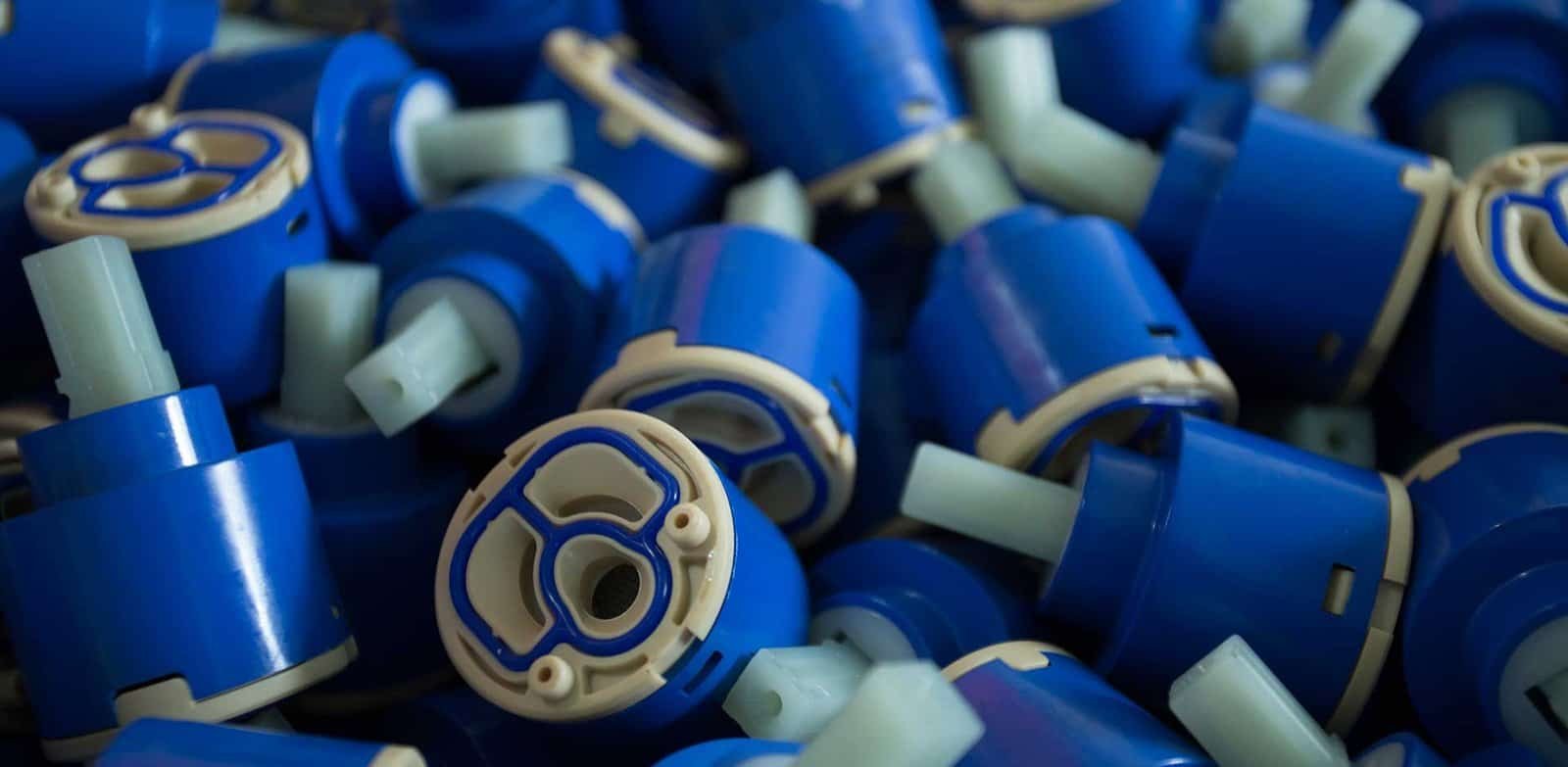
Faucet Features to Combat Hard Water
Functional Components
Pay attention to the “brains” of the faucet! Years ago, faucets relied on compression technology with rubber washers that wore out quickly and leaked frequently.
The modern standard is the ceramic disc cartridge.
These cartridges feature two extremely hard, highly polished ceramic discs that slide against each other to control water flow.
This design creates a near-perfect seal, is incredibly durable, requires only a quarter-turn for operation, and is far less prone to wear from mineral-rich water, making it an essential feature for any faucet in a hard water area.
Also, faucets with rubberized or silicone nozzles are fantastic for preventing mineral clogging, as any buildup can often be dislodged with a simple wipe of the finger.
Faucet Design Types
- Widespread Faucets: These have separate hot and cold handles and an independent spout. This design makes it “less likely to pool into a single faucet body and leave thick deposits.”
- Single-Handle Faucets: They’re generally simpler to clean because they have fewer crevices or joints where scale can accumulate.
- Wall-Mount Faucets: These faucets are connected directly to the wall, clearing space on your countertop and minimizing the risk of deposits on the fixture itself. Just a heads-up, installing these might require a plumber to avoid complications.
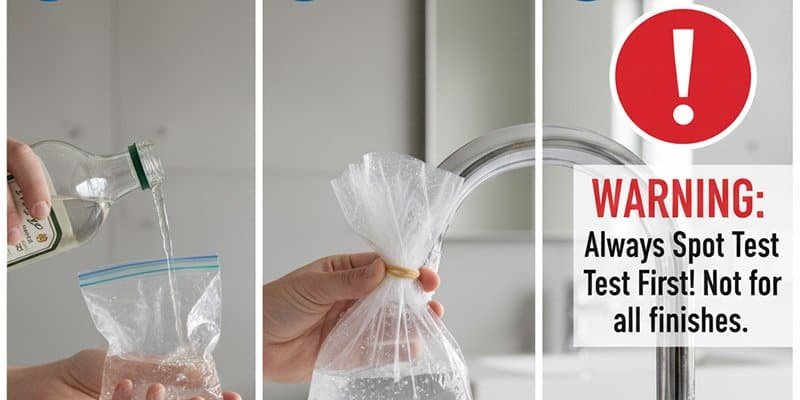
Effective Cleaning Strategies for Hard Water Stains
Okay, so you’ve got some hard water stains already? Don’t despair! Here’s how to get your faucets sparkling again.
The most common advice often comes with hidden risks, creating a “cleaning paradox” where the solution can cause more harm than the problem.
The most widely recommended DIY cleaner, vinegar, is an acid that can cause irreversible damage to certain finishes if used incorrectly.
The vulnerability of a faucet’s finish is directly related to its age, quality, and material, meaning a one-size-fits-all approach is a recipe for disaster.
The Golden Rule of Cleaning: Gentle is Best!
Remember this mantra: “If you wouldn’t use a cleaner on a favourite mirror, don’t use it on a faucet!”. Always use soft cloths, microfiber towels, and soft-bristled toothbrushes when cleaning.
What to Avoid
Steer clear of harsh chemicals, abrasive cleaners (like steel wool, scouring pads, or even Magic Erasers used too vigorously), and strong scrubbing.11 These can easily scratch, chip, or strip away your faucet’s finish, leading to permanent damage.
DIY Hard Water Heroes (with crucial warnings!)
You often have some powerful, yet gentle, cleaning tools right in your kitchen!
White Vinegar Solution
Why it works:
Vinegar is the MVP of home cleaning because it’s mildly acidic, which means it breaks down mineral deposits effectively. For an extra boost, warm your vinegar in the microwave (carefully!) before using it.
How to use it
- For removable parts (like faucet aerators): Unscrew them and let them soak in a 1:1 warm water and white vinegar bath for 15-60 minutes.
- For fixed fixtures: Use the “bag method.” Fill a plastic bag with your vinegar mix, secure it around the fixture with a rubber band, and let it soak. For light deposits on bronze, a 5 to 10-minute spray can do the trick.
Crucial Warning
Be very careful with vinegar on certain finishes! While it’s often recommended, vinegar is an acid that can damage or strip finishes like chrome, nickel, gold, and brass, especially if the finish is older, compromised, or the vinegar is left on for too long.
Always, always do a spot test in an inconspicuous area first.
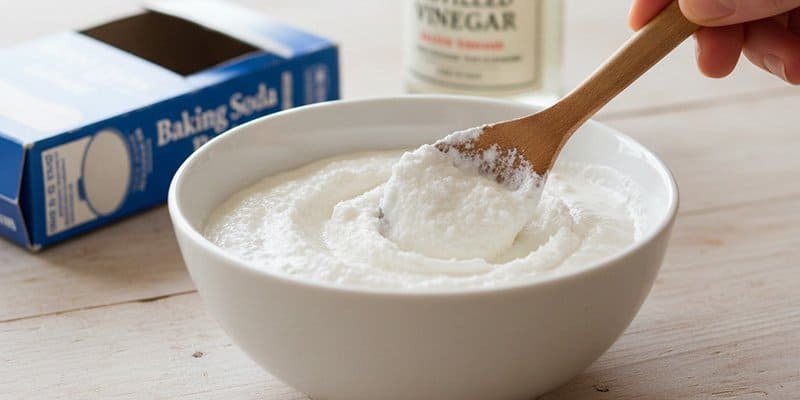
Baking Soda Paste
Why it works:
Baking soda is a gentle abrasive that can effectively scrub away mineral patches without scuffing finishes.
How to use it
Mix three parts baking soda with one part water to create a thick paste. Apply it to the crusty areas, let it sit for 10-15 minutes, then gently scrub with a soft toothbrush or microfiber scrubber. Rinse it off with a damp cloth and pat dry.
Pro Tip
Add a few drops of mild dish soap to the paste to help cut through greasy residue or soap scum.
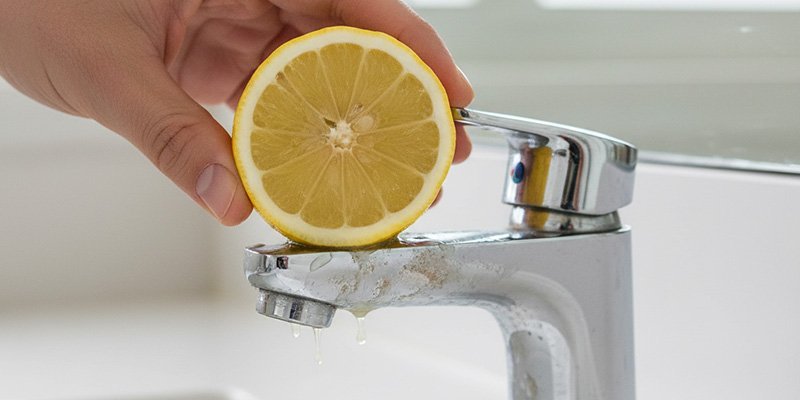
Lemon Juice
Why it works:
Lemons are cleaning powerhouses thanks to their natural citric acid.
How to use it
Cut a lemon in half and rub the juicy side directly onto the stained surface, or soak a cloth in bottled lemon juice and apply. Let it sit for a few minutes, then rinse and buff with a clean cloth.
Pro Tip
For super stubborn spots, sprinkle a little salt onto the lemon half. The combo of acid and gentle abrasiveness can power through tough buildup.
Mild Dish Soap (e.g., Dawn)
This is a universally safe and effective option for general weekly cleaning. It’s great for cutting through greasy residue and light stains.
A very small amount of dishwasher detergent on a damp cloth can also work well, as it’s mildly acidic and non-abrasive.
Commercial Descalers (for Stubborn Buildup)
When DIY methods just aren’t cutting it, store-bought solutions can save the day.
- Recommended Products: Look for products specifically labeled “lime scale remover” or “hard-water stain remover.” Popular choices include CLR, Lime Away, and Bar Keepers Friend.
- Application & Safety: Always read the instructions carefully and perform a tiny spot test in an inconspicuous area. Be aware that many commercial cleaners have finish-specific restrictions.
For example, CLR is effective on chrome and stainless steel but is not recommended for nickel, oil-rubbed bronze, brass, or copper. Some users have found success applying undiluted CLR to tough stains for a few hours, but this carries a high risk of damaging the finish if not done carefully.
Don’t Forget Internal Components!
Hard water doesn’t just affect the visible parts of your faucet.
- Aerators: These little screens at the end of your faucet are “magnets for mineral deposits”. If your water flow has slowed, your aerator is probably clogged with mineral debris. Unscrew them periodically, soak them in a safe cleaning solution (with the aforementioned warnings about vinegar), and rinse out the debris to restore full water flow. Cleaning them monthly is a great preventive habit.
- Cartridges: If hard water makes your faucet less efficient or harder to operate, you can often remove the ceramic disc cartridge and soak it in a 50-50 water/vinegar mix for about 30 minutes.
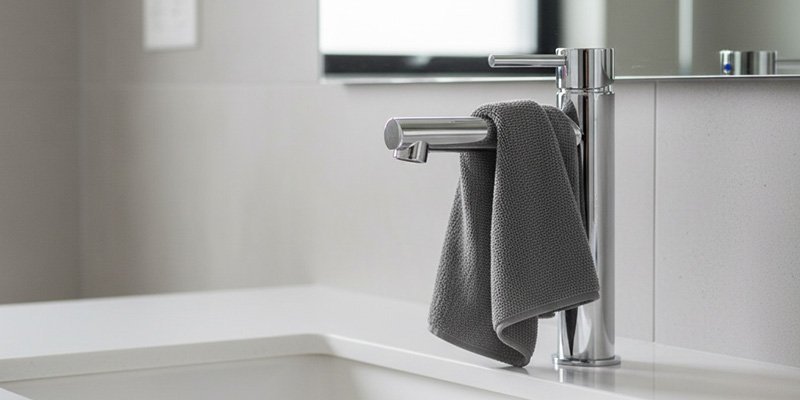
Long-Term Prevention & Protection
Now that you’ve put in the work, let’s make sure those hard water stains don’t creep back! The available solutions exist on a spectrum, directly correlating the level of investment—in either time or money—with the effectiveness of the prevention.
This allows for a personalized strategy that aligns with both budget and lifestyle, moving the question from “what is the one right answer?” to “what is the right answer for me?”
The Simplest Secret Weapon: Daily Drying
This is perhaps the easiest and most effective preventive measure: Wipe down your faucets with a soft, absorbent cloth (like microfiber) after every single use.
This simple habit stops water spots and grime from forming by preventing the water from evaporating and leaving its mineral content behind. It costs nothing but requires daily discipline, representing the baseline of proactive care.
Advanced Prevention for Hard Water
For a more comprehensive solution to hard water, consider these options:
Water Softeners or Filters
This is the “go big or go home” option and the only one that addresses the root cause of the problem.
A whole-house water softener works by using a process called ion exchange to swap out the hardness minerals (calcium and magnesium) for sodium or potassium ions, giving you water that’s much gentler on your fixtures.
This is a significant financial investment but provides a passive, automated solution that protects not just your faucets but your entire plumbing system and all water-using appliances.
If you’re not ready for that commitment, point-of-use filters for individual faucets or showerheads can also significantly cut down on buildup.
Protective Coatings
Every few months, consider applying a protective coating like a high-quality, clear paste wax (like Trewax), olive oil, or beeswax.
Use a soft cloth to apply a small amount and buff it until absorbed. This not only restores shine but also adds a water-repellent layer of protection against oxidation and stains, making it harder for minerals to adhere.
This represents a middle ground, requiring a small product investment and occasional effort.
Consistent Maintenance Habits
- Regular Gentle Cleaning: Consistent cleaning with mild solutions prevents heavy buildup from forming in the first place.
- Prompt Stain Removal: Don’t procrastinate! Address any hard water stains or mineral deposits as soon as you notice them. This prevents them from becoming more challenging and ingrained to remove later.
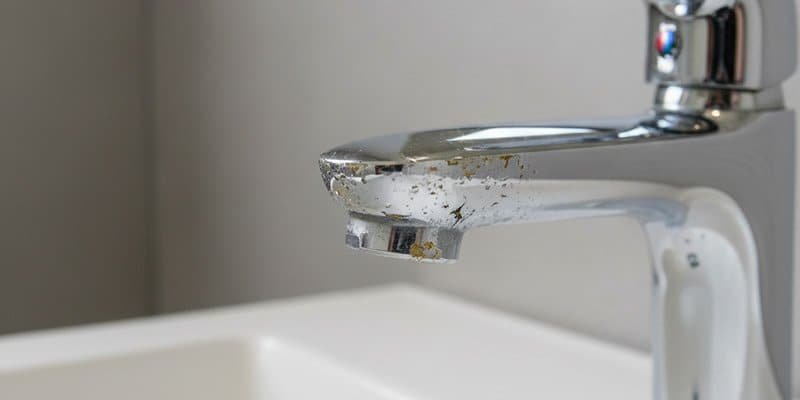
Addressing Damaged Finishes & Professional Help
Sometimes, despite our best efforts (or perhaps because of accidental harsh cleaning), things go wrong.
Recognizing Damage
Look out for signs like flaking or peeling chrome, dull patches, or exposed base metal (like the brass underneath a stripped chrome finish).3 For finishes like oil-rubbed bronze, neglecting maintenance can lead to fading and reveal “unfortunate colors”
The Harsh Reality of Stripped Finishes
This is a tough one, but often, once a faucet finish is truly stripped or compromised, there’s no easy DIY fix to restore it. Many times, replacing the faucet is the only viable option.
When to Call a Professional
- Extensive Internal Buildup: If you’re seeing severe scale buildup inside your pipes that your DIY methods can’t reach, it’s best to call a trained plumber. They have specialized equipment to inspect and remove limescale. Avoid using harsh commercial drain cleaners inside your pipes, as they can further weaken them.
- Complex Installations: Some faucet types, like wall-mount faucets, might require professional installation to avoid complications.
- Water Softener Installation/Repair: If you’re considering a water softener or yours needs repair, plumbing experts can handle the installation and maintenance.
Informed Purchasing Decisions
Thinking about upgrading your faucets? Here’s how to make choices that will stand the test of time, especially with hard water. A truly high-quality faucet is not defined by its price tag alone.
Instead, it is a combination of four key pillars: a durable base material, a resilient finish suitable for your water type, high-performance internal components, and third-party safety certification.
Learning to evaluate a faucet based on this framework allows a consumer to see past marketing and identify true, lasting quality.
The Design-Durability Trade-Off
Remember that highly aesthetic or trendy finishes, like matte black, might come with higher maintenance requirements in hard water areas.
Polished finishes, such as polished nickel, look luxurious but will demand more attention to stay gleaming.9 For camouflage, satin nickel and satin brass are your best bets.
Budget Wisely
Consider the long-term maintenance and potential replacement costs, not just the initial price tag. While zinc faucets are budget-friendly, brass and stainless steel offer superior durability and longevity, which can save you money down the line.
Prioritize Quality Components
When buying new, it’s worth researching the origin and quality of internal components like ceramic disc cartridges, because “all ceramic cartridges are not created equally”.
These components are the heart of the faucet, ensuring smooth, leak-free operation for years.
Consumer Safety: The NSF 61/9 “Lead-Free” Certification
Beyond durability, ensuring your family’s health is paramount. Look for faucets certified to NSF/ANSI/CAN 61. This is a critical American National Standard that establishes minimum health-effects requirements for products that come into contact with drinking water.
- What it means: This certification ensures that the faucet does not leach harmful levels of contaminants, including lead, into your water. Section 9 of the standard specifically covers “endpoint devices” like kitchen and bathroom faucets.
- Stricter Standards: As of January 1, 2024, the requirements for this certification became five times more protective than the previous standard, drastically reducing the acceptable amount of lead that can leach from a new faucet.
- How to check: Look for the NSF 61/9 mark or a related identifier text on the product packaging. This certification is the best way to confirm that your new faucet meets current safety standards for lead-free plumbing.
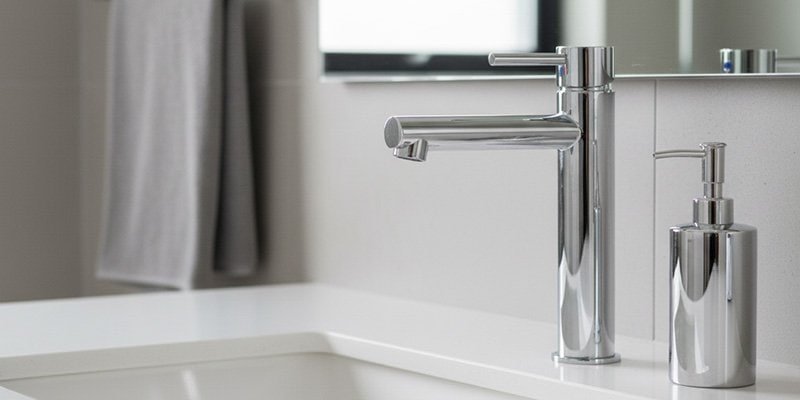
Conclusion: Master Your Water, Preserve Your Faucets
Hard water stains don’t have to be a permanent fixture in your home, and they certainly don’t have to “rule your bathroom (or kitchen!) forever”. You now have the knowledge and tools to confidently choose, clean, and protect your faucets from hard water’s detrimental effects.
Remember these key takeaways: Daily drying is your best daily defense against those pesky mineral monsters.
Choose your faucet finishes wisely, considering how they’ll interact with your local water. Use gentle, appropriate cleaners, always doing a spot test first. And for long-term relief, seriously consider a water softener or filters.
By implementing these tips, you’ll not only send those chalky deposits packing but also keep your faucets looking beautiful and functioning flawlessly for years to come. What are you waiting for? Let’s get sparkling!
Related Posts



